|
LISTEN TO THIS THE AFRICANA VOICE ARTICLE NOW
Getting your Trinity Audio player ready...
|
About 290 kilometers Southeast of Nairobi, in a sharp corner that interrupts a continuous border line that demarcates Kenya and Tanzania, is tucked a little-known natural wonder, the 4.2 km² Lake Challa.
Challa, Kenya’s second deepest lake, only second to Turkana, is found at the most extreme end of Taita Taveta County, 8 kilometers from the sleepy, lackluster frontier town of Taveta—one of the gateways to Tanzania.
To get to the lake resting on a hill from Nairobi, one would drive for slightly over 5 hours or take a flight on a light plane to Maktau airstrip on the southeastern edge of the Tsavo West national park—the dwelling place of the big five. From Maktau, you would then connect by road to Challa.
The road leading up to Lake Chala may not interest most first-time visitors. Its ragged and dusty terrain does nothing to prepare you for the beguiling scenery it ushers at the top of the caldera.
At the top, a weather-beaten concrete beacon stands, marking the southern border of Kenya and Tanzania. According to 60-year-old Joseph Leshamta, a resident of Chala, the beacon was erected 50 years ago and has chipped away over time, thanks to the elements and human carelessness, and vandalism. He says that the beacon is rebuilt after every fifty years.
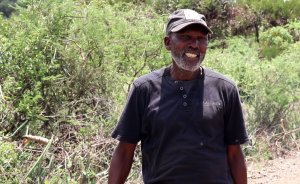
Standing on the high rocky caldera walls, one can behold the whole scope of the calm, quiet lake. In the distance, the peak of Mt Kilimanjaro is candidly visible, save for cloudy days. Down below, the scenic lake offers the most therapeutic view. Its water oscillates between turquoise, teal, and aquamarine depending on the sun’s position.
For most of the day, the water is invitingly serene. However, whirlpools occasionally disrupt its stillness sending ripples across sections of the lake at a time.
To get to the lake’s shores, one must brave a very steep careful descent. Maneuvering the cave-like rocks is no child’s play. Sometimes, where need be, incredibly if paranoid of heights, one may have to go on fours to bolster balancing and check falling.
Beyond the dense acacia trees, the call of the peregrine falcon reverberates to assert the presence of the raptors. Colobus monkeys swing low on the trees surrounding the lake. While he says that there is plenty of wildlife roaming the caldera, Leshamta insists that they are all harmless.
“In this area, there are no dangerous animals. There are apes, baboons, monkeys, and a few leopards. There are also huge snakes, such as cobras, pythons, and black and green mambas, but they have never attacked humans. Most are afraid and will take off when they hear a noise.”
According to Leshamta, swimmers and boat riders do not have to worry about crocodiles anymore. Although they were a significant risk about a decade ago, the reptiles have since gone extinct owing to the lack of proper breeding grounds. Fishermen also killed a lot of crocodiles to improve the lake’s safety.
The sole construction near the caldera sits submerged to its lintel level as proof of the steadily rising water. According to Leshamta, the building was once functional. However, with the rapid melting of snow in Mt Kilimanjaro, there has been a marked rise in the water level in Lake Chala.
Folklore versus science
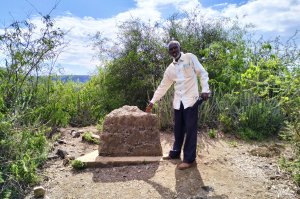
| Steve-Mokaya
Despite scientific evidence attributing the caldera’s formation to volcanic eruption over 250,000 years ago, locals still believe in folklore. Leshamta narrates that according to legend, Lake Chala was once a village on level ground. The ground and its inhabitants sank one day after the residents refused to help an old lady who passed by their village in the depth of night.
He adds that the areas around the rims of the caldera were spared since its residents offered the old woman their hospitality.
To date, the lake holds immense religious value to the Taveta people. “Any time there has been a long drought or whenever people are plagued with sickness, elders come to pray in this area,” added Leshamta.
He continued to explain their belief that some parts of the area are sacred and should not be used as a residential or commercial area. According to the locals at Chala, there once was a hotel on the Kenyan side of the lake overlooking the caldera.
Despite receiving warnings from the elders not to develop the ‘sacred land’, the hotel’s owner was bent on his mission. He built a vast resort he meant to be a prominent tourist attraction. However, the hotel collapsed more than ten years ago. Today, it is uninhabited and lies in ruins.
The lake is also a significant food source for the communities around— primarily the Taveta and Chaga people from Kenya and Tanzania, respectively. Vincent Suyani lives near the Caldera. He disclosed that Lake Chala tilapia is one of his family’s preferred fish. According to him, the lake’s tilapia is unlike any other he has tasted, urging him to visit the lake at least twice a month to purchase a few for his family.
However, on this day, there were few fish to be bought. Disgruntled fishermen were making their way up the trail, saying that they could not fish due to the lake’s clear water at the time.
“The water is so clear, you can see till the bottom of the lake. While this offers an amazing view to tourists, it hinders the fishermen’s efforts since the fish can see the nets clearly and avoid capture,” said Suyani.
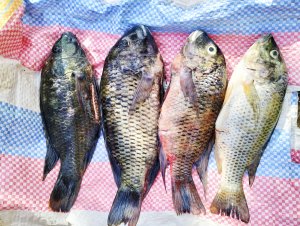
Suyani explained that it is often more convenient to buy Lake Chala tilapia from the fishmongers that sell them at the nearest center. However, if you want a cheaper price, you would have to buy fish from the lakeside.
Despite being an irresistible delicacy and the economic lifeline of many families in Chala, the Lake Chala tilapia was flagged as critically endangered by the International Union for Conservation of Nature (IUCN). IUCN reports that the primary threat against Lake Chala tilapia is siltation, significantly affecting the fish’s habitat. Introducing foreign tilapia into the lake is also believed to be fast-tracking the extinction of the Lake’s endemic tilapia.
However, research by the Kenya Marine and Fisheries Research Institute (KMFRI) in March 2020 reports that Lake Chala hosts more than 600 tonnes of fish at a depth of 20-40 meters.
Dr. James Mwaluma, who led the research team at Lake Chala, says that the lake has enough fish to sustain the livelihoods of the community around Chala. “It is. However, a deep lake and specific fishing gear such as trollers should be used for fishing,” he said.
However, he noted that getting the gear to the lake may be a challenge due to the lofty and rocky topography of the caldera.
Dr. Mwaluma further confirmed that the lake is immaculate, and the Chala fish have tested negative for any pathogens. According to their research, the lake could be a perfect site for cage culture.
Tourist attraction
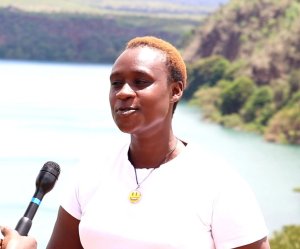
Besides being a central food basket in the area, the Challa has significant tourism potential, though it is largely untapped. Pockets of local and international tourists filter in sporadically to catch the vista, feel the breeze, watch the animals, go boat-riding and swim.
Florian Mashalla, though a resident of Taita Taveta County, confesses that she has never visited Lake Chala before our meeting at the lake. Notwithstanding, she has always been aware of its existence through stories and the internet.
Today, with two friends in tow, she decided to tour the lake and see what the fuss is all about. “I am glad to visit the lake finally. Many people travel great distances to see the lake, yet I live in Taveta and have never seen it. So I took the challenge and came here with my friends,” Mashalla confessed.
Unlike most people, she only intended to see the lake from a distance. Her phobia, she said, would never allow her to board a boat across the vast lake. Her friend, Vostalinos Areri, had a different story. Having visited the lake four times before, he was eager to show his friends around.
“I am proud of the lake since it is a tourist attraction and a nice place for social activities with friends,” he said.
Areri praises the water’s fresh taste, saying that during his visits, he sometimes drinks directly from the lake and leaves feeling refreshed. He disclosed that Lake Chala is the main source of water in the area, adding that the water is first treated before being piped to various households.
Conservation efforts
Local communities from the Kenyan side, alarmed by the wanton destruction of the forest surrounding the lake, three years ago formed a community-based organization to arrest the buffer’s destruction and pollution of the near-pristine lake. Thus, the Imbaria Beach Management Unit was birthed.
Leshamta is a member of the conservation organization committed to safeguarding the lake. He says the organization has been mandated to protect the lake, regulate fishing and prevent wildlife hunting.
He reiterates that the members of IMBU take their roles seriously since by preventing wildlife hunting, they safeguard the surrounding areas from attacks from the predators in the caldera’s thickets and forest. “If we hunt the monkeys and other prey, it is only a matter of time before the predators wander into our homes,” he said.
According to him, the IMBU’s impact at the lake is unmatched. Most members are great swimmers, having swum in the lake since childhood. They have time and again proven heroic whenever there were drowning risks in the lake.
“Although the water is still, it runs deep, even in the areas close to the shores. It is even deeper than Lake Victoria. The deepest part measured is more than 100 Meters deep. I have saved numerous people from drowning in this lake. Some get in the water thinking the shores are shallow,” he said, adding that his latest save was a month ago when a young woman slipped into the deep water and could not swim.
Chares Kuria, the Kenya Forest Service (KFS) County Conservator for Taita Taveta, said the government plans to gazette and fence the forest surrounding the caldera. Once gazetted, they will partner with IBMU to manage the lake and forest.
Kuria said that the law requires every gazetted forest to have a Community Forest Association (CFA) composed of the residents near forests. With the help of the locals, protecting the wildlife and the trees will be much easier.
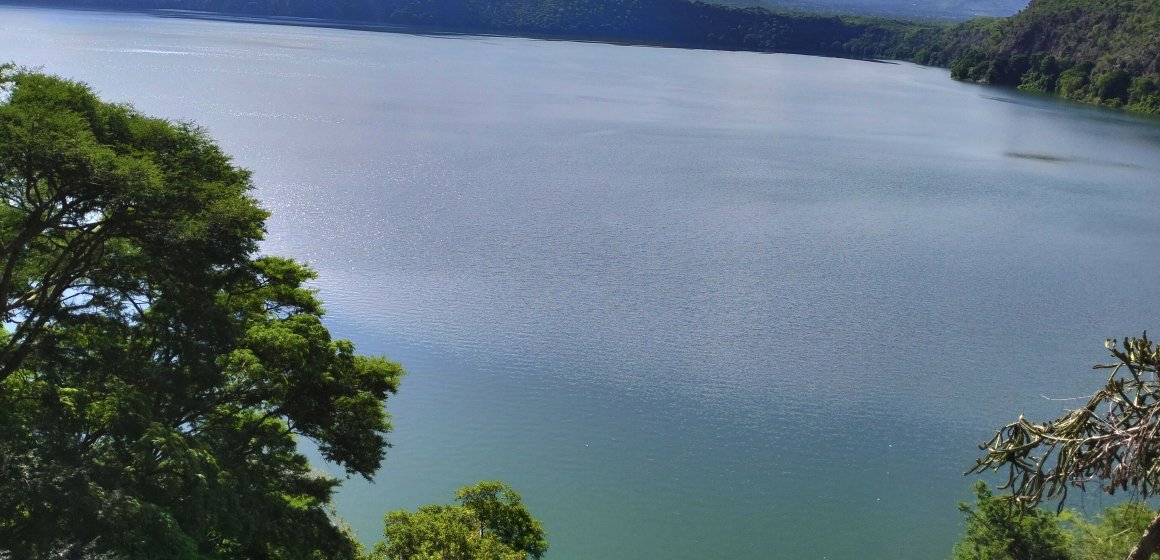
















































LEAVE A COMMENT
You must be logged in to post a comment.